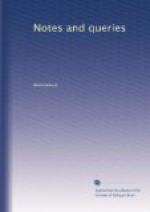“There was a little frog, lived
in the river swim-o,
And there was an old crow lived in the
wood of Ennow,
Come on shore, come on shore, said the
crow to the frog again-o;
Thank you, sir, thank you, sir, said the
frog to the crow of Ennow,
...
But there is sweet music under yonder
green willow,
And there are the dancers, the dancers,
in yellow.”
M.
“She ne’er with treacherous Kiss.”—Can any of your readers inform me where the following lines are to be found?
“She ne’er with treacherous
kiss her Saviour stung,
Nor e’er denied Him with unholy
tongue;
She, when Apostles shrank, could danger
brave—
Last at His cross, and earliest at His
grave!”
C.A.H.
“Incidit in Scyllam” (Vol. ii., p. 85.).—
“Incidit in Scyllam, cupiens vitare
Charybdim;
Sie morbum fugiens, incidit in medicos.”
Has any of your readers met with, or heard of the second short line, appendant and appurtenant to the first? I think it was Lord Grenville who quoted them as found somewhere together.
FORTUNATUS DWARRIS.
Nicholas Brigham’s Works.—Nicholas Brigham, who erected the costly tomb in Poets’ Corner to the memory of Geoffrey Chaucer (which it is now proposed to repair by a subscription of five shillings from the admirers of the poet), is said to have written, besides certain miscellaneous poems, Memoirs by way of Diary, in twelve Books; and a treatise De Venationibus Rerum Memorabilium. Can any of the readers of “NOTES AND QUERIES” state whether any of these, the titles of which are certainly calculated to excite our curiosity, are known to be in existence, and, if so, where? It is presumed that they have never been printed.
PHILO-CHAUCER.
Ciric-Sceat, or Church-scot.—Can any of your readers explain the following passage from Canute’s Letter to the Archbishops, &c. of England, A.D. 1031. (Wilkins Conc. t. i. p. 298):—
“Et in festivitate Sancti
Martini primitae seminum ad ecclesiam,
sub cujus parochia quisque
degit, quae Anglice Cure scet
nominatur.”
J.B.
[If our correspondent refers to the glossary in the second vol. of Mr. Thorpe’s admirable edition of the Anglo-Saxon Laws, which he edited for the Record Commission under the title of Ancient Laws and Institutes of England, he will find s.v. “Ciric-Sceat—Primitiae Seminum church-scot or shot, an ecclesiastical due payable on the day of St. Martin, consisting chiefly of corn;” a satisfactory answer to his Query, and a reference to this very passage from Canute.]
Welsh Language.—Perhaps some of your correspondents would favour me with a list of the best books treating on the Welsh literature and language; specifying the best grammar and dictionary.




